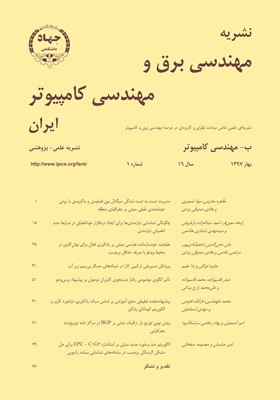پروتکل مسیریابی ترکیبی کارا در شبکههای حسگر بیسیم زیر آب
محورهای موضوعی : مهندسی برق و کامپیوتر
1 - دانشگاه آزاد اسلامی واحد نجفآباد
2 - دانشگاه اصفهان
کلید واژه: تجمیع دادهخوشهبندیشبکههای حسگر بیسیم زیر آبفازیمسیریابی ترکیبی کارا,
چکیده مقاله :
شبکه حسگر بيسيم زير آب (UWSN) نوعي خاص از شبکههاي حسگر ميباشد که در دهههاي گذشته، حوزه عملياتي آن به نقاط زير آبي نيز توسعه يافته است اما اين نوع از شبکهها به دليل عدم حضور GPS (سيستم مکانيابي سراسري) چالشهاي بسياري دارند. اين شبکهها با محدوديتهايي از قبيل تأخير انتشار زياد، پهناي باند کم، نرخ خطاي بيتي بالا، جابهجايي، حافظه و باتري محدود، محققان را با چالشهاي فراواني روبهرو ساختهاند. در مقايسه با شبکههاي حسگر زميني، حسگرها در شبکههاي بيسيم زير آب به سبب استفاده از تکنولوژي صوتي در ارتباطات، انرژي بيشتري مصرف ميکنند. انگيزه اين پژوهش پيشنهاد يک الگوريتم مسيريابي براي محيطهاي سيستمي زير آبي با انرژي محدود ميباشد. گرههاي حسگر واقعشده در بستر دريا نميتوانند به طور مستقيم با گرههاي نزديک سطح ارتباط برقرار کنند، بنابراين نيازمند ارتباطات چندگامي مهياشده با طرح مسيريابي مناسب ميباشند. در شبکههاي حسگر بيسيم، خوشهبندي گره روشي رايج براي سازماندهي ترافيک داده و کاهش ارتباطات درون شبکهاي همراه با بهبود قابليت مقياسپذيري و بهبود توازن بار به همراه کمينهکردن مصرف انرژي کلي سيستم ميباشد. بنابراين در اين مقاله يک پروتکل مسيريابي خوشهبندي فازي همراه با تکنيک تجميع داده با مصرف انرژي متعادل براي UWSNها پيشنهاد ميشود. نتايج شبيهسازي نشان ميدهد که در پروتکل پيشنهادي توزيع مصرف انرژي در شبکه به طور يکنواخت بوده، از متوسط مصرف انرژي و تعداد بستههاي مسيريابي کاسته شده و در نهايت باعث بهبود در نرخ تحويل بسته و گذردهی نسبت به الگوريتمهای DABC و IDACB شده است.
Underwater Wireless Sensor Network (UWSN) is a kind of sensor networks that their operational fields have been developed under water in recent decades, although these networks deal with lots of challenges due to lack of the GPS1. These networks encounter researchers with many challenges by some limitations like high propagation delay, low bandwidth, high bit error rate, movement, limited battery and memory. In comparison with terrestrial sensor networks, sensors in the UWSN consume energy more because they use acoustic technology to communicate. Motivation of this research is proposing a routing protocol for underwater systematic settings with a limited energy. The settled sensor nodes in underwater cannot communicate directly with nodes near surface, so they need prepared multi hop communications with a proper routing plan. In wireless sensor networks, node clustering is a common way to organize data traffic and to decrease intra-network communications along with scalability and load balance improvement plus reducing of overall energy consumption of system. Therefore, in this article a fuzzy clustering routing protocol with data aggregation and balanced energy consumption for UWSNs is proposed. Simulation results show that in the proposed protocol, energy consumption becomes more uniformly distributed in the network and average of the nodes' energy usage and number of routing packets decreases and finally, packet delivery ratio and throughput are improved in the network in comparison with DABC3 and IDACB4 algorithms.


